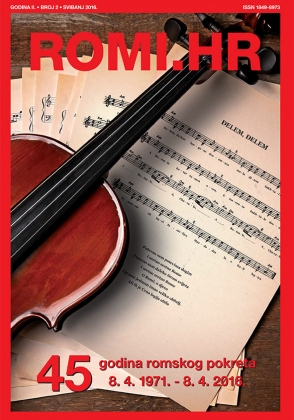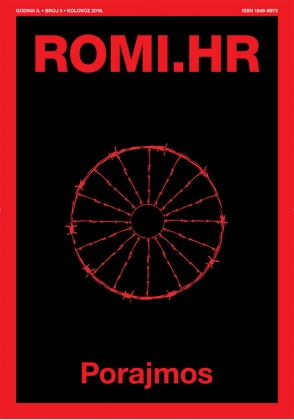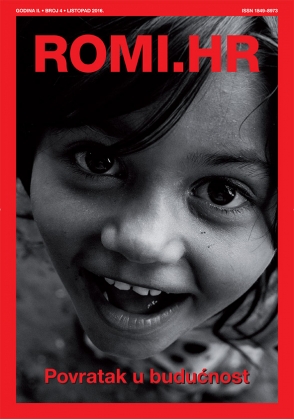Vijesti ROMI.HR
/
Svjetski dan kulturne različitosti za dijalog i razvoj je međunarodni dan promicanja različitosti, a proglašen je od strane Ujedinjenih naroda. Svjetski dan kulturne različitosti održava se svake godine 21. svibnja. Opća skupština Ujedinjenih naroda proglasila je ovaj dan na osnovu UNESCO-ve Opće deklaracije o kulturnoj raznolikosti iz studenog 2001. godine. Svjetski dan kulturne različitosti za dijalog i razvoj proglašen je Rezolucijom Ujedinjenih naroda broj 57/249.
Prijevod: Milica Kuzmanović
Ako tražimo razloge zašto je bilo važno proglasiti dan posvećen promicanju multikulturalnih prijateljskih vrijednosti, kroz povijest možemo pronaći brojne sukobe koji su to dovodili u pitanje. Međutim, događaj koji je za posljedicu imao pokretanje inicijative za uspostavljanje ovog Dana, bilo je rušenje statua Bude u Bamijanu u Afganistanu, uništenih od strane talibana, u ožujku 2001. godine. Taj barbarski čin poslao je snažnu poruku vjerske netolerancije.
Bude iz Bamijana bile su dvije monumentalne statue Gautama Bude iz 6. stoljeća. Statue su izrezbarene u litici stijene u dolini Bamijan, u regiji Hazarajat, u središnjem Afganistanu, 230 kilometara sjeverozapadno od Kabula, na nadmorskoj visini od 2500 metara. One predstavljaju kombinaciju grčkog i budističkog klasičnog stila. Niža statua izrezbarena je 507. godine i doseže 38 metara, a viša statua datira iz 554. godine i visoka je 55 metara. Ove statue bile su najveće izrezbarene statue Budinog lika u stojećem položaju. Statua velikog Bude u Leshanu, smještena u južnom dijelu kineske pokrajine Sečuan, visoka je nevjerojatnih 71 metar. Ova statua izrađena između 713. godine i 803. godine, prikazuje Budu u sjedećem položaju.
Historijska dokumentacija govori o proslavama koje su se svake godine održavale privlačeći veliki broj hodočasnika, a pred kipove su prinošeni darovi. Kipovi Bude iz Bamijana bile su možda najpoznatija kulturna znamenitost te regije. UNESCO ih je proglasio svjetskom baštinom, kao i kulturni krajolik i arheološke ostatke u dolini Bamijan.
Namjera talibana da unište statue, najavljena 27. veljače 2001. godine, izazvala je reakciju međunarodne zajednice koja je prosvjedovala i osudila ovu najavu. Prema riječima glavnog direktora UNESCO-a Koïchiro Matsuura, održan je sastanak veleposlanika iz 54 država članica Organizacije islamske konferencije (OIC) na kojem su se sve države OIC-a - uključujući Pakistan, Saudijsku Arabiju i Ujedinjene Arapske Emirate - tri zemlje koje su službeno priznale talibansku vladu - pridružile prosvjedu za očuvanje spomenika. Iako Indija nikada nije priznala talibanski režim u Afganistanu, ponudila se organizirati prijenos ugroženih umjetničkih djela u Indiju.
Kipove su konačno razneseni i uništeni u ožujku 2001. godine, od strane talibana, a po nalogu njihovog vođe Mullaha Mohammeda Omara, nakon što ih je talibanski režim proglasio idolima suprotnim islamu.

Islamska država Iraka i Levanta (ISIL) također je uništila važne elemente svjetske kulturne baštine. Godine 2014., mediji su izvještavali o uništavanju džamija i hramova sunita i šiita, širom područja koja je zauzeo ISIL. Džamija i svetište Arba'een Wali u Tikritu, koje sadrži četrdeset grobnica iz doba Umara, razneseno je u napadu eksplozivnom 24. rujna 2014. godine. Dana 26. veljače 2015. godine, ISIL je raznio Zelenu džamiju iz 12. stoljeća u središtu Mosula.
Nakon zauzimanja Palmire u Siriji od strane ISIL-a, 27. lipnja 2015. godine ISIL je srušio drevni kip Lava Al-lāta u Palmiru. Nekoliko drugih statua iz Palmire, također je uništeno od strane ISIL-a. Dana 23. kolovoza 2015. godine, ISIL je raznio Hram Baalshamina iz 1. stoljeća. Samo nekoliko dana kasnije, 30. kolovoza 2015. godine, ISIL je eksplozivom srušio hram Bel. Prema izvješću koje je 3. rujna 2015. godine objavio ASOR, inicijativa za očuvanje sirijske baštine, ISIL je u dvije faze uništio i sedam drevnih kula u Palmiri. Posljednja faza uništavanja dogodila se između 27. kolovoza i 2. rujna 2015. godine, uključujući uništavanje Elabelske kule iz 2. stoljeća, nazvane "najistaknutijim primjerom specifičnih pogrebnih spomenika u Palmiri." Ranije su uništene i drevne grobnice Iamlika i Atenatena, a Monumentalni luk u Palmiri također je razoren u listopadu 2015. godine.

Hatra je bio drevni grad u iračkoj provinciji Ninava i al-Jazira, veliki utvrđeni grad i glavni grad prvog Arapskog Kraljevstva. U arhitekturi hramova može se prepoznat spoj helenističkog i rimskog utjecaja s istočnjačkim ukrasnim obilježjima, što svjedoči o veličini njihove civilizacije. Dana 7. ožujka 2015. godine, različiti izvori, uključujući iračke dužnosnike, izvijestili su kako su militantne skupine Islamske države Iraka i Levanta (ISIL) započele rušenje ostataka drevnog grada Hatre.

Važnost kulturne baštine leži u činjenici kako ona može stvoriti osjećaj jedinstva i pripadnosti unutar skupine, omogućiti nam bolje razumijevanje prethodnih generacija, povijesti i našeg podrijetla. Zbog toga, neki spomenici, hramovi i drugi elementi, u ovom slučaju vjerski, nadilaze nas kao pojedince te pripadaju cijelom čovječanstvu. Kako bismo sačuvali našu povijest, naše podrijetlo i našu kulturu za čovječanstvo, ključno je promicati poštovanje svetih mjesta, čak i ako ona ne pripadaju našoj vjerskoj zajednici.
Ovi činovi vjerske netrpeljivosti razlog su postojanja Svjetskog dana kulturne različitosti za dijalog i razvoj. Kako bismo izbjegli ratove, sukobe, eskaliranje nasilja prouzrokovanog kulturološkim, vjerskim ili etničkim pitanjima, moramo promicati vrijednosti poput ljudskih prava, međukulturalnog razumijevanja, prijateljstva i tolerancije u svim oblicima.
Moramo ohrabriti društva i osigurati im sredstva kojima će iskorijeniti sve oblike mržnje koji danas postoje prema drugima i drugačijima. To je bi mogao biti još jedna napor učinjen u cilju stajanja na put sveopće prisutnom nasilju.
Ako pogledamo povijest čovječanstva, naći ćemo kako se većine sukoba temelji na netoleranciji. Netolerancija prema drugačijima, prema drugim nacionalnostima, drugoj vjerskoj skupini, prema drugom narodu. Promicanjem međusobnog razumijevanja među ljudima, društvima i narodima, možemo početi razmišljati o ujedinjenom, tolerantnijem i solidarnijem svijetu.
Kako su Romi tradicionalno nomadski narod, te se kao nomadi nikada nisu nastanjivali na jednom određenom mjestu duži vremenski period, Romi nemaju nasljeđe koje se može naći u materijalnom obliku kao što su spomenici, ikone ili arhitektura. Međutim, Romi su uvijek bili važan dio umjetničke povijesti, naročito u glazbi. To je razlog zašto je prepoznavanje Flamenka, andaluzijskog i romskog glazbenog žanra, kao nematerijalne baštine čovječanstva, od strane UNESCO-a 2010. godine, postalo važno za romsku zajednicu. Mnoge nevladine organizacije bore se za prepoznavanje same romske kulture kao nematerijalne baštine čovječanstva, zbog svojih jedinstvenih i posebnih osobina, koje se ne mogu naći u nijednoj drugoj zajednici.

The World Day for Cultural Diversity for Dialogue and Development is a United Nations–sanctioned international holiday for the promotion of diversity. It is held on May 21. The United Nations General Assembly proclaimed this holiday due to UNESCO's Universal Declaration on Cultural Diversity in November 2001. It was proclaimed by UN Resolution 57/249
If we look for the reasons regarding the need to stablish a day to promote multicultural friendliness, values we can find many conflicts throughout history. However, the triggering event was the demolition of the Buddha statues in Bamiyan, Afghanistan destroyed by the Taliban in March 2001, that act of barbarism represented a strong message of religious intolerance.
The Buddhas of Bamyan were two 6th-century monumental statues of Gautama Buddha carved into the side of a cliff in the Bamyan valley in the Hazarajat region of central Afghanistan, 230 kilometres northwest of Kabul at an elevation of 2,500 metres Built in 507 CE and 554 CE, the statues represented the classic blended style of Gandhara (Greco-Buddhist art). The tallest one is 55 meters tall, while the smaller one is 38 meters. They were the largest examples of standing Buddha carvings in the world. The Leshan Giant Buddha located in Sichuan China is taller with an incredible 71-meters tall built between 713 and 803, however it represents a sitting Buddha.
Historic documentation refers to celebrations held every year attracting numerous pilgrims and that offers were made to the monumental statues. They were perhaps the most famous cultural landmarks of the region, and the site was listed by UNESCO as a World Heritage Site along with the surrounding cultural landscape and archaeological remains of the Bamiyan Valley.
The Taliban's intention to destroy the statues, declared on 27 February 2001, caused the reaction of the international community protesting and condemning the declaration. According to UNESCO Director-General Koïchiro Matsuura, a meeting of ambassadors from the 54 member states of the Organization of the Islamic Conference (OIC) was conducted and all OIC states—including Pakistan, Saudi Arabia, and the United Arab Emirates, three countries that officially recognized the Taliban government—joined the protest to spare the monuments without success. Although India never recognized the Taliban regime in Afghanistan, they offered to arrange for the transfer of all the artifacts in question to India
The statues were finally blown up and destroyed in March 2001 by the Taliban, on orders from leader Mullah Mohammed Omar, after the Taliban government declared that they were idols.

The Islamic State of Iraq and the Levant (ISIL) have also destroyed important elements of the World Cultural Heritage. In 2014, media reported destruction of multiple, Sunni and Shiite, mosques and shrines throughout areas captured by ISIL. On 24 September 2014, the Arba'een Wali Mosque and Shrine in Tikrit, containing forty tombs from the Umar era, was blown up. On 26 February 2015 ISIL blew up the 12th century Green Mosque in central Mosul.
Following the capture of Palmyra in Syria, ISIL was reported as not intending to demolish the city's World Heritage Site. On 27 June 2015, however, ISIL demolished the ancient Lion of Al-lāt statue in Palmyra. Several other statues from Palmyra reportedly confiscated from a smuggler were also destroyed by ISIL. On 23 August 2015, it was reported that ISIL had blown up the 1st-century Temple of Baalshamin. On 30 August 2015, ISIL demolished the Temple of Bel with explosives. According to the report issued on September 3, 2015 by ASOR Syrian Heritage initiative, ISIL also destroyed seven ancient tower tombs in Palmyra since the end of June over two phases. The last phase of destruction occurred between August 27 and September 2, 2015, including the destruction of the 2nd-century AD Tower of Elahbel, called "the most prominent example of Palmyra's distinct funerary monuments.” Earlier, the ancient tombs of Iamliku and Atenaten were also destroyed. The Monumental Arch was also blown up in October of the same year.
Hatra was an ancient city in the Niniva Governorate and al-Jazira region of Iraq. A large fortified city and capital of the first Arab Kingdom. In the temples, the architecture is a mix of Hellenistic and Roman blend with Eastern decorative features, which attest to the greatness of its civilization. On 7 March 2015, various sources including Iraqi officials reported that the militant group Islamic State of Iraq and the Levant (ISIL) had begun demolishing the ruins of Hatra.

The importance of Cultural heritage lays on the fact that it can create a sense of unity and belonging within a group and allows us to better understand previous generations and the history of where we come from. That is why some monuments, temples, and other elements, in these cases religious ones, trascend us and belong to humankind. In order to preserve our history, our backgrounds and our culture as humanity, it is crucial to promote respect of holy places, even if they are not the ones belonging to your particular group.
These act of religious intolerance are a symbol of what the World Day for Cultural Diversity for Dialogue and Development is about. In order to avoid more wars, more conflicts, more escalating violence regarding cultural, religious or ethnics issues we have to promote values such as human rights, intercultural understanding and friendship and tolerance in all its forms.
We must encourage and give societies the tools to erase any form of hate to the different one, as this would be a step forwards towards the end of lots of violence reigning in our world today.
If we take a look at the history of humanity, we can find than the root to most conflicts are based on intolerance. Intolerance towards the different, towards another ethinic, another religious group, towards another nation. By promoting the mutual understanding among peoples, societies, nations we can start thinking of a more united, tolerant and solidary world.
Roma people due to its nomadic nature, never settling in one specific place do not have a legacy that can be found in material things such as monuments, icons or architecture. However, they have always been important in art and specifically music. This is why the recognition of Flamenco, an Andalusian and Roma music genre, as Immaterial Patrimony of Humanity by UNESCO in 2010 became an important hit for Roma community. Many NGO’s are even struggling for the Roma culture itself to be recognized as part of the Immaterial Patrimony of Humanity, due to its unique and particular characteristics, which cannot be found in any other community.













